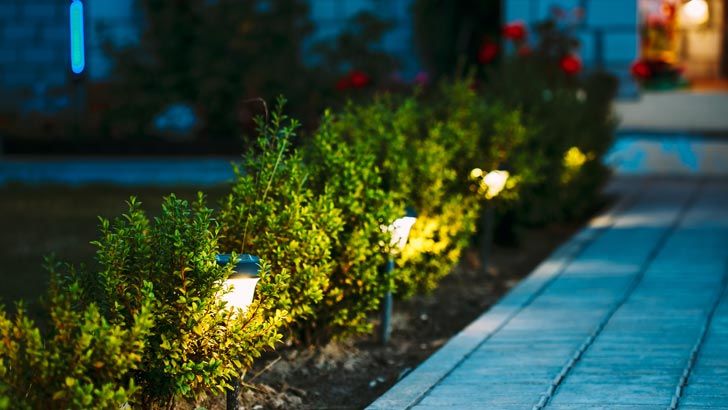Eight ways your garden can save you water, power and money
By Nicola Field
Reducing our burden on the planet and cutting costs has never been so vital. With a few clever strategies you can save water, power and money, and turn your outdoor space into a sustainable budget-friendly environment.
1. Go for grey power
Recycling household water is a great way to keep your garden well hydrated and slash bills at the same time. Greywater systems store water from showers, baths, basins and washing machines for use on the garden or for flushing toilets.
Australian households produce an average of 340 litres of greywater each day. It's an ideal source of year-round irrigation and will cut water bills. The best bit? Greywater is nutrient rich, and your plants will likely love it.
Check your council for greywater restrictions that may apply in your area. If you get the all-clear, greywater systems can start in price from $650, though the cost can rise to several thousand dollars for systems with a high level of filtration.
2. Plant a tree, cut power bills
Planting shade trees, especially on the western side of your home, can lower interior temperatures through passive cooling, reducing the need for power-hungry air-conditioning.
The problem is that as lot sizes shrink, there isn't always space for generous shade trees in modern backyards. An alternative can be to plant trees in the nature strip outside your home. It can make a significant difference to internal temperatures - and the value of your property.
The Cool Streets project under way in western Sydney found that street trees have the potential to cut household power bills by up to $400 annually. It's all about combatting the "heat island" effect where temperatures rise when homes are surrounded by heat-
reflecting concrete and bitumen rather than natural vegetation.
The rules around planting trees on nature strips vary between councils. Always consult your local government authority before adding some greenery, though you could be pleasantly surprised. Many councils run "free tree" programs where street trees can be planted at no cost to households. Some, like Brisbane City Council, give away native trees and shrubs for planting in your own garden - not just the council strip.
3. Make your own mulch
Mulch is to garden plants what insulation is to home comfort. It keeps the soil cool and moist and cuts water evaporation by around 25%. That means the potential to trim garden water bills by a quarter.
Even better, mulch can be extremely budget-friendly. Raked up leaves, lawn clippings (provided your lawn is weed free) and torn up newspapers all work well as organic mulch. If you're thinking of using heavy-duty black plastic to reduce evaporation, bear in mind that rainwater can't permeate plastic, so your plants will miss out on a natural soaking.
4. Grow your own greens
No matter whether you live in a high-rise apartment or a suburban home - or if you rent rather than own - your outdoor space can be used to provide fresh produce.
Australian households spend an average of $15 to $19 each week on veggies. That's almost $1000 annually.
Already, one in two households grows a few veggies, and a survey by the Australia Institute found nine in 10 food-gardening households say they save money. The savings are only likely to increase as climate change puts pressure on the cost of mass-produced fruit and veg.
Happily, a wide variety of vegetables are super-easy to grow. If you're a beginner, try fail-safes like spinach, beetroot, broccoli and cauliflower. Cherry tomatoes, lettuce and silverbeet are well suited to high rise living.
Six-cell punnets of seedlings cost around $8 from nurseries and hardware stores. Allow a couple of extra bucks for bags of potting mix if you're in a unit, though there may be no need to outlay money on planter tubs. Styrofoam boxes, which are great for growing herbs and veggies, are often advertised for free on classified sites such as Gumtree.
5. Show your soil some love
Keeping your garden healthy doesn't have to mean spending a fortune on fertiliser. Composting kitchen scraps and garden waste can mean a 100% saving on fertiliser as well as diverting waste from landfills. In fact, Better Health Victoria advises households against using chemical fertilisers on backyard vegetable gardens.
Building a backyard compost heap from vegetable scraps, lawn clippings and garden debris like leaves and twigs can cost nothing at all. In tight spaces, a compost bin can be a more compact option. Purpose-built bins are priced from around $85, but you may be able to do better. The social enterprise Compost Revolution has partnered with councils across Australia to offer composting gear subsidised at up to 80% off retail prices. Get in touch with your council to see what's up for grabs.
6. Add a water feature
Research from Europe shows that fountains in city parks can reduce surrounding temperatures by up to three degrees, with the lower temps felt as much as 30 metres away.
It's possible to replicate the same passive cooling effect in your home by installing a garden pond or water feature outside windows or in courtyards.
It works because when water evaporates it draws heat from the surrounding air to provide a natural cooling effect.
While the sky can be the limit for the cost of water features, they typically start at about $150. Choose a unit with a solar-powered pump to avoid adding to your electricity bill.

7. Cut the cost of outdoor lighting
Lighting accounts for around 10% of the average home electricity budget, so exterior lighting may only be a small fraction of your total power bill. Even so, installing solar lights can produce long-term savings. The catch is that quality solar lights aren't cheap.
"The storage capacity of solar garden lights has improved significantly, but stake lights costing a few dollars don't offer lasting value," says licensed electrician Mike Terrell. "You really need to spend upwards of around $30 per light - preferably aiming for LED globes - to get a product that is durable and will provide a decent level of illumination."
On the plus side, solar lights have no wiring as PV cells are usually built into the casing, which means they can be easily installed and moved around without the need for a tradie.
Terrell suggests you check with the retailer whether replacement bulbs or batteries are available. Some units do not provide replacement options.
8. Harvest your rainwater
Australian households collectively spend over $5 billion on water each year. As our urban populations grow, water bills look set to rise. Already Perth residents can pay up to $4.55 per thousand litres of water. In Sydney, the opening of the Kurnell desalination plant has pushed water rates up from $2.11 to $2.24 per kilolitre.
Harvesting natural rainwater is a smart solution.
The average suburban roof has the potential to capture around 100,000 litres of rainwater annually. This assumes yearly rainfall of 500mm, and even our driest state capital, Adelaide, meets this target, receiving around 551mm in annual rainfall.
It makes a backyard rainwater tank a money-saving investment, especially as a quarter of household water is used on gardens.
Installing a rainwater tank does involve a capital outlay. A 5000-litre tank can cost around $898 from major hardware suppliers. Allow about $100 for fittings, and from $200 for a pump if you want to do more than gravity-feed water to garden beds.
This cost can often be recouped through council rebates. As a guide, Rous County Council in northern NSW provides a rebate of $800 to residents who install a 5000-litre tank, with an extra $620 if it's connected to household toilets and a further $550 if the tank is hooked up to a washing machine. Check your council to see if any rebates are available.
Get stories like this in our newsletters.



